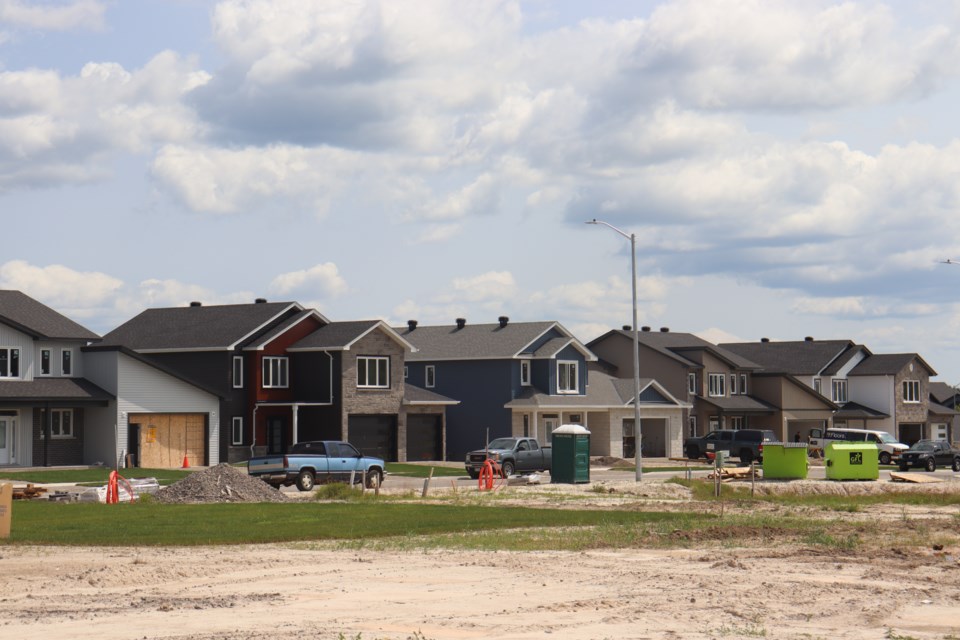EDITOR'S NOTE: A version of this article originally appeared on SooToday on July 30. It is being republished here for readers who may have missed it.
A new report from the city's planning department confirms what is already painfully clear to many Saultites: housing is hard to come by in this town.
Sault Ste. Marie needs 3,115 new housing units over the next 13 years to accommodate an anticipated population growth of more than 8,400, the report concludes. An estimated 779 new units are needed over the next three years alone.
Among the new residential units needed are up to 1,160 apartments, and between 1,955 and 2,265 single-detached, semi-detached, or row houses.
The Housing Needs Assessment, a 41-page document prepared by the city's planning and enterprise services staff, was presented at the most recent city council meeting.
City council accepted the report and directed city staff to apply for the Canada Mortgage and Housing Corporation (CMHC) Housing Accelerator Fund (HAF), which provides incentive funding to municipal governments aimed at increasing housing supply.
Following a significant period of decline, the city’s population has been on the rise since 2018 with boosts in migrants, international immigrants, and non-permanent residents. According to Statistics Canada, there were 75,673 people living in Sault Ste. Marie in 2022.
That year also marked the highest number of building permits issued for new units in the past decade with 331. This included 211 permits for apartment units.
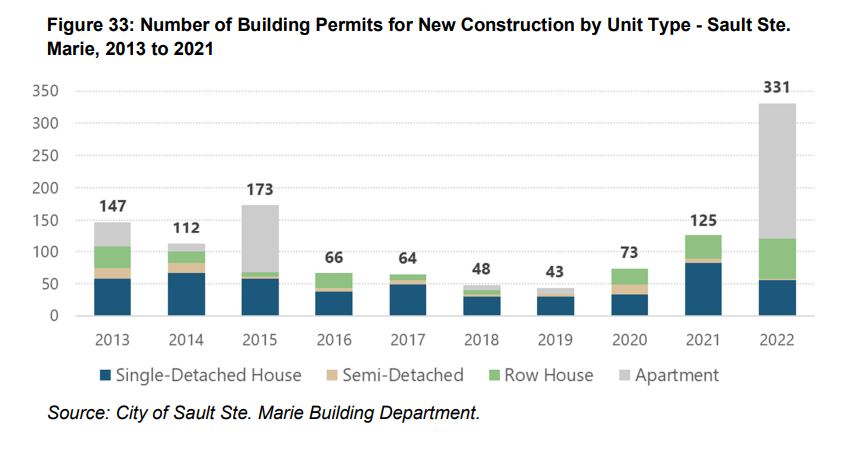
Meanwhile, in 2021, the assessment identified 4,255 households in Sault Ste. Marie with three or more bedrooms were occupied by just one person in each – mainly seniors.
The report suggested the construction of 500 senior units would be necessary to force a turnover of existing two- and three-bedroom homes for the growing number of families moving to the city.
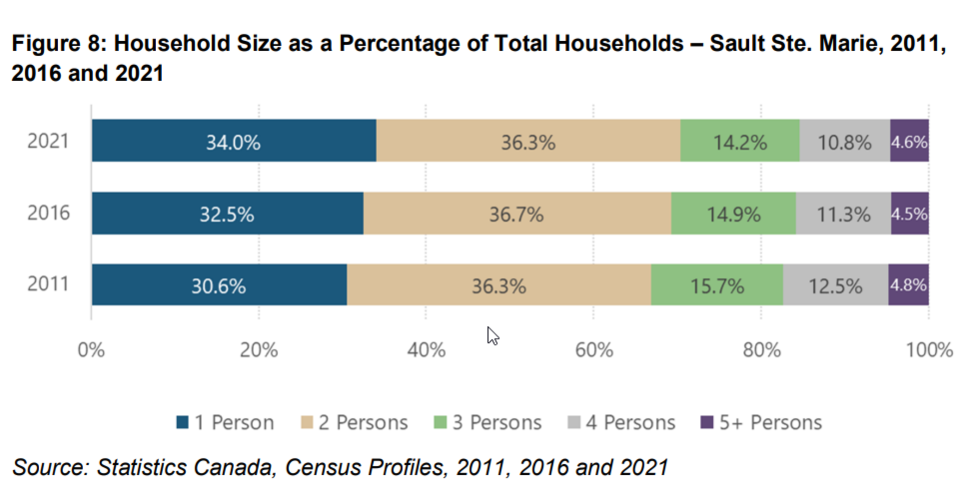
There were 32,530 occupied dwellings in Sault Ste. Marie with an average of 2.2 persons per household in 2021. Seventy-five per cent of dwellings in the Sault were built before 1980, leaving the physical state of some houses in question.
More than 2,300 homes, or 7 per cent of all dwellings in the Sault, need major repairs. These include houses with defective plumbing or electrical wiring, as well as structural repair requirements to walls, floors, or ceilings.
A larger proportion of rental dwellings (8.5 per cent) required major repairs in Sault Ste. Marie in 2021 compared to owner occupied dwellings (6.4 per cent).
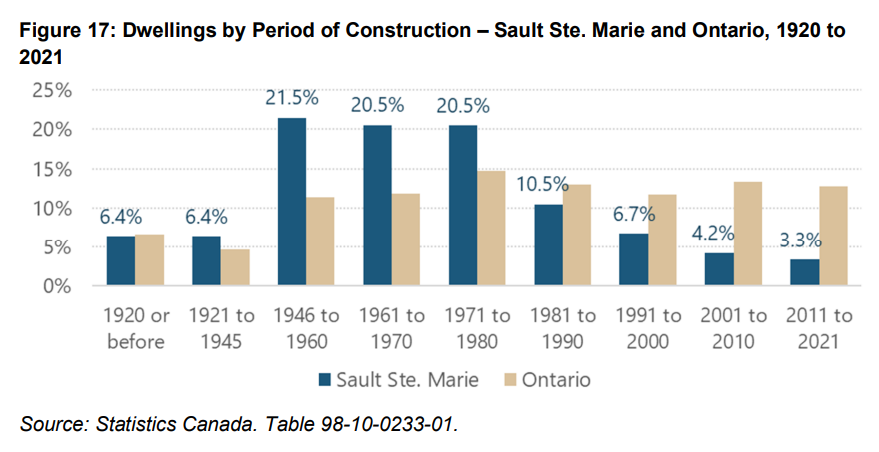
Homeownership sits at 68 per cent in the city – nearly identical to the provincial average.
Affordable ownership housing in the Sault last year was a purchase price of $281,300 or below, while affordable rental housing was a monthly rental rate of $1,015 or below (including utilities).
According to the Ministry of Municipal Affairs and Housing, resale prices grew by approximately 80 per cent between 2017 and 2022 – far outpacing the growth in household income during this time. In 2022, only the households with an income near the 70th percentile or higher would be able to afford an average house of any type within the Sault.
The 70th percentile for 2022 income in the Sault was $120,400 for all households and $66,700 for rental households.
Households with incomes in the 40th percentile could afford average priced semi-detached units only, while low-income earners would be unlikely to purchase a home in Sault Ste. Marie and subsequently rely on the rental market or subsidized housing.
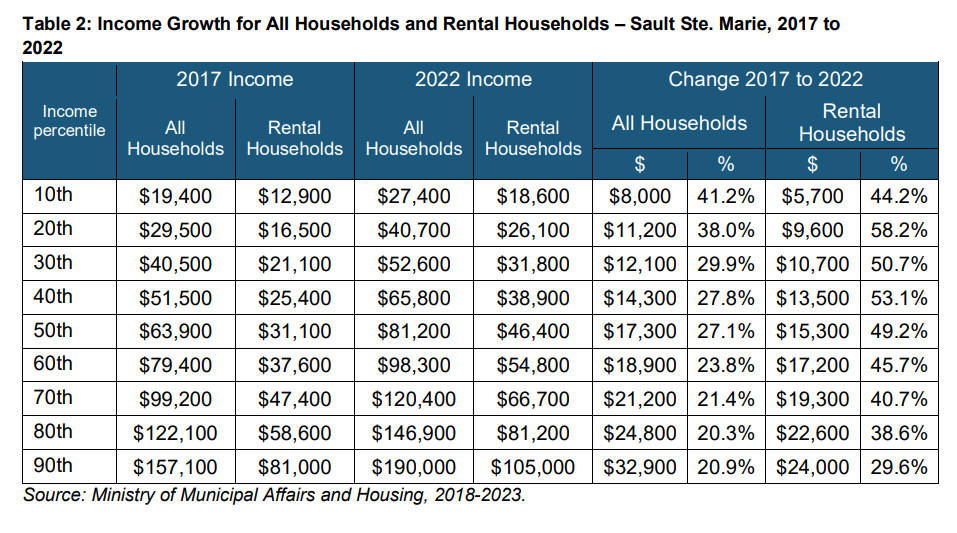
Average rental rates have increased by 56.1 per cent in Sault Ste. Marie between 2011 and 2022 at a lower rate than the income growth of all households. Therefore, the report concluded that renters are likely required to pay more of their gross income on rents over time and leaving less for other necessities.
Currently, rental housing comprises 31.7 per cent of all dwellings in town. Half of them are one-person households.
Meanwhile, local homelessness was identified to have increased 163 per cent from 2018 to 2021, with a 700 per cent increase in supportive housing required to meet current demand.
It’s estimated that Sault Ste. Marie requires a minimum of 80 permanent supportive housing units to combat homelessness. As of July 2023, there were just 10 such units in the city.
1,700 households are currently on the wait list for subsidized housing, which represents 5.2 per cent of all households in the Sault. About two-thirds of those waiting for a unit are seeking a one-bedroom unit and approximately one-third of those on the wait list are residents aged 60 and older, the report concludes.
The full Housing Needs Assessment report can be viewed on pages 86-127 by clicking here.
A link to this evening’s live city council meeting will be posted to the SooToday website shortly before 5 p.m.
